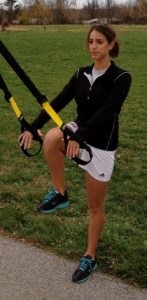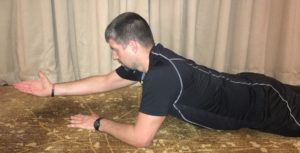by Mitch Hauschildt, MA, ATC, CSCS
I get a lot of questions from people who want to know what my favorite “core strengthening’ exercises are. I know that people are well intended with this question, so I try hard to answer them in a simple, yet authentic manner that makes sense. But, the reality is that I tend to see the “core” a bit different than most clinicians.
I honestly rarely use the term “core” anymore because I think the term is misleading. I usually use “trunk” because I think that it is more appropriate verbiage as to what stabilizes the midsection, spine, ribcage and pelvis. Honestly, my favorite way to describe the “core” is the deep front line, but if you haven’t read Anatomy Trains, that is a useless term.
The other difference between my definition and other’s is the term “strengthening.” I have some issues with it because very few people have “weak” trunk stabilizers. Most people have poor timing of their stabilizers and they don’t turn on and off the way that they are supposed to. But, they are almost always strong enough. I know they have strength because they usually walk through the doors of my training room.
So, with that all said, we can have a good discussion regarding training the trunk stabilizers to be more efficient and work in the right sequence and at the right time. That is where I spend most of my time.
Most people love their planks, deadbugs, and birddogs, which I don’t necessarily hate, but I also have a host of movements that I believe are more efficient, easier to master, and do a better job preparing people to perform at a high level. Here are 7 such exercises that I love, but are non-traditional for most people with regards to trunk stabilization.
 Marching: Pretty much everyone in my facility is going to perform a core engaged march at some point. We use bands, suspension trainers and sometimes an overhead load to tell the trunk stabilizers to turn on first before any movement happens and then off after the movement is finished. By feeding forward with the arms and helping the midline stabilizers to be active, we have a stable platform for the extremities to work off of.
Marching: Pretty much everyone in my facility is going to perform a core engaged march at some point. We use bands, suspension trainers and sometimes an overhead load to tell the trunk stabilizers to turn on first before any movement happens and then off after the movement is finished. By feeding forward with the arms and helping the midline stabilizers to be active, we have a stable platform for the extremities to work off of.
 Rolling: If you have read some of my content, it doesn’t surprise you that I like multi-segmental rolling. I have a DVD dedicated to it. It is such a great exercise because it is a basic neurodevelopmental pattern. It also teaches movement in the transverse plane, which is incredibly important. Further, it teaches a low threshold recruitment strategy, which is how we function 95% of our days, but most people don’t do well.
Rolling: If you have read some of my content, it doesn’t surprise you that I like multi-segmental rolling. I have a DVD dedicated to it. It is such a great exercise because it is a basic neurodevelopmental pattern. It also teaches movement in the transverse plane, which is incredibly important. Further, it teaches a low threshold recruitment strategy, which is how we function 95% of our days, but most people don’t do well.
Carries: We do a ton of carries in our facilities. Sometimes they are a traditional farmer’s carry with a load in the hands. Sometimes we move the load up or down or offset the load. Other times we mix up the load to use kettlebells, sandbags, plates, dumbbells or whatever else we have around. I view carries as a moving plank. They are a great way to modify or regress a plank for those who can’t get up and down or who are looking for a different training stimulus.

Sphinx Arm Raise: This is a hidden gem. It is very simple and teaches timing and rotational stability. It is as simple as putting someone on their belly and propping them up onto their elbows (Sphinx position). Have them apply some pressure into the floor with their elbows. This will activate the trunk stabilizers. Then simply raise one arm out in front to remove a base of support. The goal is to be able to maintain a neutral spine throughout the movement and not see any shoulder or hip rotation.
Halos: Halos are great for building tri-planer stability throughout the trunk. By moving a load around the head (or waist as a regression), we teach the midline to be stable with a moving load. This exercise can be progressed and regressed in a ton of ways by simply changing postural positions (i.e. tall kneeling, ½ kneeling, standing, etc) and modifying the load.
Hovers: Quadruped hovers have completely replaced planks in my practice. I find that very few people can do a good plank and they can get frustrating to teach, so I decided to go a little different route. The issue for most people with planks is that they dump their pelvis into anterior rotation and slam their lumbar vertebrae against each other, causing pain and defeating the purpose of the exercise. But, by flexing the hip and knee to 90 degrees, we take all of that away. The hover is just as challenging to perform as a plank but is much easier to master and sets people up for success.
Posterior Rocks: This is an exercise that I used a few years back and stopped for some reason, but I have brought it back recently and I’m loving it again. You can use a stability ball or band behind the hips to provide a load, but the overall goal is to reset timing and sequencing, like many of the aforementioned movements. When the hips rock back into the load, the trunk stabilizers have to turn on. Then we remove part of the base of support (lifting an arm) and you are training stability, motor control and rotation all at once.
There are honestly a number of other movements and exercises that I really like that aren’t included in this list and maybe that will be a topic for a later post. The main item I hope you take from this article is to be creative, understand the goals of your training and work to find new and innovative ways to train your patients or clients.


Many times we have to go back to more basic moves to address the dysfunction. I like these. Looking forward to your next batch.
Great stuff!